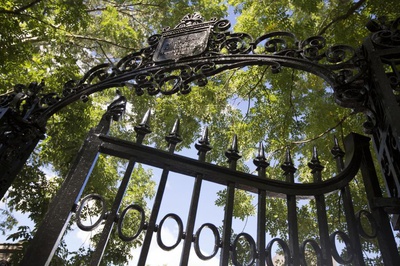
News
Harvard Researchers Develop AI-Driven Framework To Study Social Interactions, A Step Forward for Autism Research

News
Harvard Innovation Labs Announces 25 President’s Innovation Challenge Finalists

News
Graduate Student Council To Vote on Meeting Attendance Policy

News
Pop Hits and Politics: At Yardfest, Students Dance to Bedingfield and a Student Band Condemns Trump

News
Billionaire Investor Gerald Chan Under Scrutiny for Neglect of Historic Harvard Square Theater
INGERSOLL LECTURE
Delivered by Dr. W. S. Bigelow on "Immortality in Northern Buddhism."
Dr. William S. Bigelow '71, of Boston, delivered the annual Ingersoll Lecture in the New Lecture Hall last night.
The view of immortality of man which I shall set forth is, broadly speaking, that of the Buddhist religion. But Buddhism, like many other great religions, is divided into main churches, and sub-divided into sects; we find conspicuously two great main divisions, commonly called Northern and Southern Buddhism, the former having its recognized centre in the north of India, in Nepaul, the latter in Ceylon. We are to discuss tonight the teachings of Northern Buddhism.
Something exists: however reckless and extravagant this statement seems, let us accept it provisionally and term that something ourselves. Man is a compound of a material part called the body, and an intangible part called the soul. The facts about the body are simple; the soul being invisible is only assumed to exist, first through its apparent effects, secondly through self-consciousness. There is but one form of self-consciousness to which we are not passive; we may feel pain or sensation, but we never say that we feel the will. It is always subjective and active.
Now the Buddhist doctrine is this,--that a man consists of states of consciousness; and in the persistence of these states the question of man's immortality is bound up. States of consciousness are divisible into two classes: those that originate from without and those that originate from within. The first are conditioned by time and space, the latter are not. A state of consciousness may originate through the senses, by the will, or spontaneously.
Matter is conditioned by space and time; direct sensory consciousness is equally so conditioned. The space and time relations to matter may be summed up in one word--separateness; those of consciousness in the opposite term--unity. Consciousness has no dimensions; it includes the universe itself, and self is co-extensive with the universe. Each man therefore carries in himself the conditions and limitations of his own universe. To expand away from the material means spiritual growth; to contract towards it means spiritual deterioration.
The fact of the resemblance of off-spring to parents is a matter of everyday knowledge. In the East this is regarded as an illustration of rebirth or incarnation; the soul having renewed its relations with the material by rebirth. Character is habitual consciousness.
Glorified celestial existence is the final goal of most religions. In Northern Buddhism this is not the goal but an intermediate step in normal evolution between the human and the infinite consciousness.
Want to keep up with breaking news? Subscribe to our email newsletter.
Most Read
- Pritzker Says Harvard Is ‘All Over’ Supporting Students Whose Visas Were Revoked
- 3 Harvard Students, 2 Recent Grads Had Visas Revoked
- After Trump’s Demands, Dean of Students Says College Diversity Offices Have No Plans To Cut Programming
- Free Speech Has Become Free Expression. That’s a Problem.
- ‘A Campaign of Anti-Palestinian Racism’: HDS Students, Alumni Decry Program Suspension
From Our Advertisers

Over 300+ courses at prestigious colleges and universities in the US and UK are at your disposal.

Where you should have gotten your protein since 1998.

Serve as a proctor for Harvard Summer School (HSS) students, either in the Secondary School Program (SSP), General Program (GP), or Pre-College Program.

With an increasingly competitive Law School admissions process, it's important to understand what makes an applicant stand out.

Welcome to your one-stop gifting destination for men and women—it's like your neighborhood holiday shop, but way cooler.

HUSL seeks to create and empower a community of students who are seeking pathways into the Sports Business Industry.
